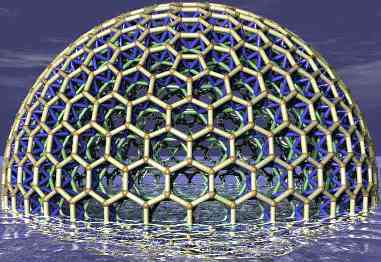
HexDome
Hexagonal Geodesic Domes - Stability Tests
Stability Tests
One of the ideas presented on this web site is that support
for hexagonal geodesic domes can be provided purely
by tension components.
In order to investigate this idea experimentally, we
performed some tests under simulation.
There are three distinct types of connection components in
these sorts of dome - and any of them could be replaced with
tension components.
Configurations with the middle and outer layers replaced
by tension components are not stable - even in theory.
Of the remaining configurations, stability is roughly as follows:
| \ |
None |
Inner |
Middle |
Outer |
Inner+Middle |
Inner+Outer |
| Hex 4 |
10 |
9 |
5 |
5 |
5 |
5 |
| Hex 12 |
10 |
8 |
4 |
4 |
4 |
4 |
| Hex 22 |
10 |
7 |
1 |
3 |
1 |
4 |
| Hex 32 |
10 |
6 |
1 |
3 |
1 |
4 |
| Hex 40 |
10 |
5 |
1 |
3 |
1 |
4 |
| Tri 12 |
10 |
- |
- |
- |
- |
- |
| Tri 22 |
9 |
- |
- |
- |
- |
- |
| Tri 32 |
8 |
- |
- |
- |
- |
- |
| Tri 40 |
7 |
- |
- |
- |
- |
- |
Key:
1 is stable provided is is only minimally perturbed;
2 means the structure can't survive hitting a wall;
3-10 indicate greater stability (scale is rather subjective);
Interpretation
These results suggest that the middle layer being able to
support compression loads is rather important in terms of
providing stability.
Structures where the middle layer consisted of ropes tended
to be weak - structures where the the middle layer consisted
of struts tended to be much stronger - even if these were
the only struts in the system.
Making the middle layer the structural one produced pleasingly
resiliant behavour - the structure would bend significantly
without breaking.
Structures where only the outer layer consists of
struts are not - unfortunately - among the most stable of
the configurations tested.
Tim Tyler |
Contact |
http://hexdome.com/
|